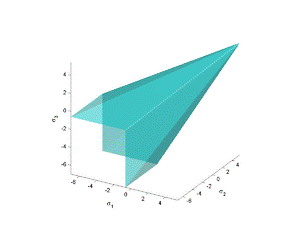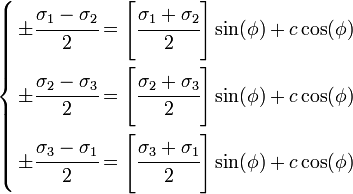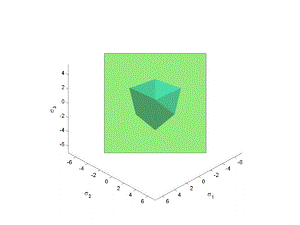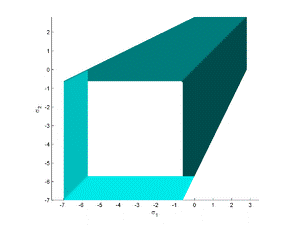Mohr–Coulomb failure criterion


Figure 1: View of Mohr–Coulomb failure surface in 3D space of principal stresses for 
The Mohr–Coulomb [5] failure criterion represents the linear envelope that is obtained from a plot of the shear strength of a material versus the applied normal stress. This relation is expressed as

where τ is the shear strength, σ is the normal stress, c is the intercept of the failure envelope with the τ axis, and φ is the slope of the failure envelope. The quantity c is often called the cohesion and the angle φ is called the angle of internal friction . Compression is assumed to be positive in the following discussion. If compression is assumed to be negative then σ should be replaced with − σ.
If φ = 0, the Mohr–Coulomb criterion reduces to the Tresca criterion. On the other hand, if  the Mohr–Coulomb model is equivalent to the Rankine model. Higher values of φ are not allowed.
the Mohr–Coulomb model is equivalent to the Rankine model. Higher values of φ are not allowed.
From Mohr's circle we have

where

and σ1 is the maximum principal stress and σ3 is the minimum principal stress.
Therefore the Mohr–Coulomb criterion may also be expressed as

This form of the Mohr–Coulomb criterion is applicable to failure on a plane that is parallel to the σ2 direction.
Mohr–Coulomb failure criterion in three dimensions
The Mohr–Coulomb criterion in three dimensions is often expressed as

The Mohr–Coulomb failure surface is a cone with a hexagonal cross section in deviatoric stress space.
The expressions for τ and σ can be generalized to three dimensions by developing expressions for the normal stress and the resolved shear stress on a plane of arbitrary orientation with respect to the coordinate axes (basis vectors). If the unit normal to the plane of interest is

where  are three orthonormal unit basis vectors, and if the principal stresses σ1,σ2,σ3 are aligned with the basis vectors
are three orthonormal unit basis vectors, and if the principal stresses σ1,σ2,σ3 are aligned with the basis vectors  , then the expressions for σ,τ are
, then the expressions for σ,τ are

The Mohr–Coulomb failure criterion can then be evaluated using the usual expression

for the six planes of maximum shear stress.
| [show]Derivation of normal and shear stress on a plane |
  Figure 2: Mohr–Coulomb yield surface in the π-plane for Figure 2: Mohr–Coulomb yield surface in the π-plane for  |   Figure 3: Trace of the Mohr–Coulomb yield surface in theσ1 − σ2-plane for Figure 3: Trace of the Mohr–Coulomb yield surface in theσ1 − σ2-plane for  |
Mohr–Coulomb failure surface in Haigh–Westergaard space
The Mohr–Coulomb failure (yield) surface is often expressed in Haigh–Westergaad coordinates. For example, the function

can be expressed as

Alternatively, in terms of the invariants p,q,r we can write

where

| [show]Derivation of alternative forms of Mohr–Coulomb yield function |
